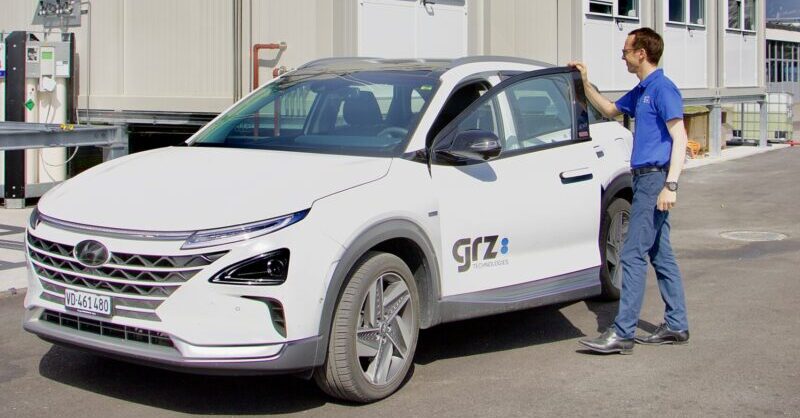Hydrogen fuel may be the dominant energy carrier in a fully renewable energy system, a hydrogen engine is required to generate useful work with it. The development of hydrogen engines encompasses two primary types: hydrogen fuel cells and hydrogen internal combustion engines (ICEs). Both approaches aim to harness the clean energy potential of hydrogen, yet, they operate on fundamentally different principles and technologies. Both are share the common property that they run on a renewable fuel and produce environmentally friendly emissions.
Hydrogen fuel cell engine #
Hydrogen fuel cell cells convert hydrogen gas into electricity through an electrochemical process. This technology is at the forefront of hydrogen-powered transportation due to its high efficiency. The most-used type of fuel cells are Proton Exchange Membrane (PEM) fuel cells, e.g., as manufactured by Hyundai Motor Company. They use a solid polymer electrolyte. Hydrogen gas is split into protons and electrons at the anode. The protons pass through the membrane to the cathode, while the electrons travel through an external circuit, generating electricity. At the cathode, protons, electrons, and oxygen combine to form water and heat. The reactions taking place are:
Anode: H2 → 2H++2e−
Kathode: 2H++2e−+0.5O2 → H2O + heat
A key advantage of the technology is its high efficiency: fuel cells convert chemical energy directly into electrical energy with efficiencies often exceeding that of internal combustion engines. The only byproducts are water vapor and heat, so all emissions are environmentally benign and the ever-more-important label “zero emission” is clearly applicable. Finally, the technology is scalable from small to large scale and therefore suitable for an entire range of applications. Some fuel cells as small as 3mm have been presented to the public. Today, challanges that are still inhibiting the increased use are the high costs of fuel cell materials, particularly platinum catalysts.

Hydrogen internal combustion engine (ICEs) #
Hydrogen internal combustion engines (ICEs) represent another approach to utilizing hydrogen as a fuel. Unlike fuel cells, hydrogen ICEs burn hydrogen in a manner similar to traditional gasoline, diesel, or gas engines. During the combustion process, hydrogen is injected into the engine’s combustion chamber, where it mixes with air and is ignited by a spark plug. The combustion of hydrogen generates high-temperature gases that expand and drive the engine’s pistons, producing mechanical power. In simple terms, the ongoing reaction is:
2H2 + O2 → 2H2O + Energy
A key advantage of this technology is that existing knowledge and technology about internal combustion engines can be reused. Further, the approach allows for a high power output and a high power density. While not completely emission-free, hydrogen combustion primarily emits water vapor, with significantly lower levels of NOx compared to conventional fuels.
The key challenges are the reduced emission, which poses extra challenges to overall system design since it implies that more hydrogen is required for the same amount of usable energy.
Historical and current developments #
The idea of using hydrogen in engines dates back over a century. François Isaac de Rivaz built the first hydrogen-powered internal combustion engine in 1806. However, it was not until the 20th century that significant advancements were made in both fuel cells and hydrogen ICEs. In the 1960s and 1970s, NASA’s Apollo program utilized hydrogen fuel cells for spacecraft power, demonstrating their reliability and efficiency. Thereafter, automotive manufacturers like Toyota, Honda, and Hyundai have developed hydrogen fuel cell vehicles (FCVs) such as the Toyota Mirai and the Hyundai Nexo. Simultaneously, companies like BMW have experimented with hydrogen ICEs, highlighting the versatility of hydrogen as a fuel.
The future of the hydrogen engine #
Hydrogen engines, encompassing both fuel cells and internal combustion engines, offer promising pathways toward sustainable transportation. While hydrogen fuel cells lead the charge with their high efficiency and zero emissions, hydrogen ICEs provide a more immediate application by leveraging existing engine technology. Both types face challenges in cost, infrastructure, and efficiency, but ongoing industrialization continues to pave the way for hydrogen’s role in the future of clean energy.





